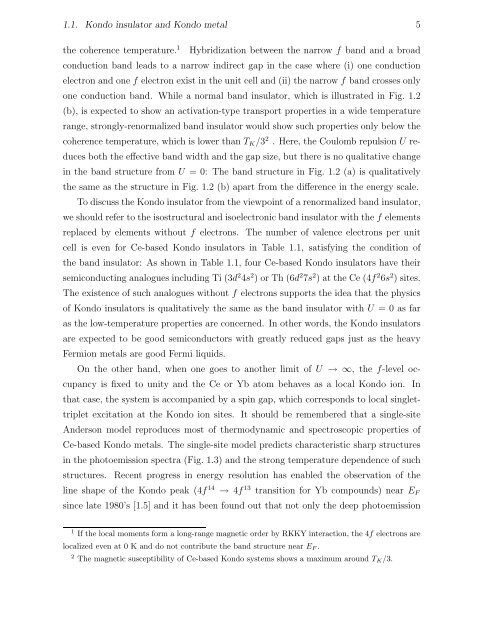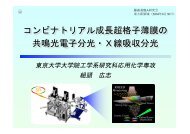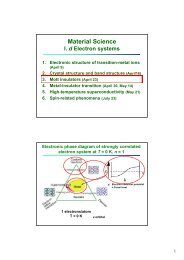Thesis High-Resolution Photoemission Study of Kondo Insulators ...
Thesis High-Resolution Photoemission Study of Kondo Insulators ...
Thesis High-Resolution Photoemission Study of Kondo Insulators ...
Create successful ePaper yourself
Turn your PDF publications into a flip-book with our unique Google optimized e-Paper software.
1.1. <strong>Kondo</strong> insulator and <strong>Kondo</strong> metal 5<br />
the coherence temperature. 1 Hybridization between the narrow f band and a broad<br />
conduction band leads to a narrow indirect gap in the case where (i) one conduction<br />
electron and one f electron exist in the unit cell and (ii) the narrow f band crosses only<br />
one conduction band. While a normal band insulator, which is illustrated in Fig. 1.2<br />
(b), is expected to show an activation-type transport properties in a wide temperature<br />
range, strongly-renormalized band insulator would show such properties only below the<br />
coherence temperature, which is lower than TK/32 . Here, the Coulomb repulsion U reduces<br />
both the effective band width and the gap size, but there is no qualitative change<br />
in the band structure from U = 0: The band structure in Fig. 1.2 (a) is qualitatively<br />
the same as the structure in Fig. 1.2 (b) apart from the difference in the energy scale.<br />
To discuss the <strong>Kondo</strong> insulator from the viewpoint <strong>of</strong> a renormalized band insulator,<br />
we should refer to the isostructural and isoelectronic band insulator with the f elements<br />
replaced by elements without f electrons. The number <strong>of</strong> valence electrons per unit<br />
cell is even for Ce-based <strong>Kondo</strong> insulators in Table 1.1, satisfying the condition <strong>of</strong><br />
the band insulator: As shown in Table 1.1, four Ce-based <strong>Kondo</strong> insulators have their<br />
semiconducting analogues including Ti (3d 2 4s 2 )orTh(6d 2 7s 2 ) at the Ce (4f 2 6s 2 ) sites.<br />
The existence <strong>of</strong> such analogues without f electrons supports the idea that the physics<br />
<strong>of</strong> <strong>Kondo</strong> insulators is qualitatively the same as the band insulator with U = 0 as far<br />
as the low-temperature properties are concerned. In other words, the <strong>Kondo</strong> insulators<br />
are expected to be good semiconductors with greatly reduced gaps just as the heavy<br />
Fermion metals are good Fermi liquids.<br />
On the other hand, when one goes to another limit <strong>of</strong> U →∞, the f-level occupancy<br />
is fixed to unity and the Ce or Yb atom behaves as a local <strong>Kondo</strong> ion. In<br />
that case, the system is accompanied by a spin gap, which corresponds to local singlettriplet<br />
excitation at the <strong>Kondo</strong> ion sites. It should be remembered that a single-site<br />
Anderson model reproduces most <strong>of</strong> thermodynamic and spectroscopic properties <strong>of</strong><br />
Ce-based <strong>Kondo</strong> metals. The single-site model predicts characteristic sharp structures<br />
in the photoemission spectra (Fig. 1.3) and the strong temperature dependence <strong>of</strong> such<br />
structures. Recent progress in energy resolution has enabled the observation <strong>of</strong> the<br />
line shape <strong>of</strong> the <strong>Kondo</strong> peak (4f 14 → 4f 13 transition for Yb compounds) near EF<br />
since late 1980’s [1.5] and it has been found out that not only the deep photoemission<br />
1 If the local moments form a long-range magnetic order by RKKY interaction, the 4f electrons are<br />
localized even at 0 K and do not contribute the band structure near EF .<br />
2 The magnetic susceptibility <strong>of</strong> Ce-based <strong>Kondo</strong> systems shows a maximum around TK/3.






